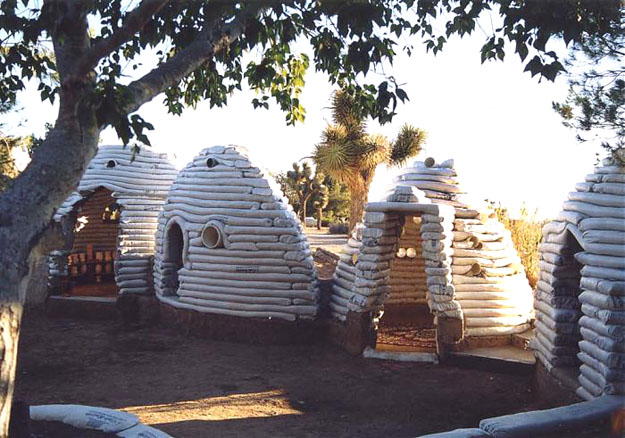
2. Breifly describe why each of these 3 construction methods are energy efficient?
This blog gives students an opportunity to weigh in on environmental issues. About every 5-7 days a free-response questions is provided on an environmental issues. By allowing them to see other students' responses from within our school and other participant schools, student can evaluate their own responses and provide critical and meaningful feedback to others. Please join us, post a response in the comment section, and participate in our community.




A recent NPR.org podcast reports an increase in overfishing, mainly due to the U.S. and Europe's desire to eat more fish. This got me wondering how many other countries are jumping on the "eating fish is healthier" bandwagon and contributing to the rapid decline of global fisheries. A quick search of Google News found an article summarizing a series of studies that local taboos in most developing countries have stymied overfishing of local reefs. In this light, then...
Questions:
1. List one developed country and one developing country that are to some extent contributing to the decline of global fisheries. Describe the difference between these two countries in terms of their GDP. What is their import/export of global fish stocks?
2. Describe one cultural practice in a developed country that is contributing to the decline of global fisheries and one cultural practice in a developing country that is helping to prevent the decline of global fisheries.
3. Describe two types of technology that are being used in commercial fishing and for each type of technology describe one environmental problem that arises from its use.
4. What is one legislative law that regulates global fisheries, and explain under what circumstances this law is suspended and/or reinstated.
Resources:
A Dire Prediction for the Future of Sea Life - http://www.npr.org/templates/story/story.php?storyId=6469061
Local Taboos Stop Overfishing -
http://www.sciencealert.com.au/news/20082301-16816.html
Until the Fish are All Gone -
http://www.nytimes.com/2008/01/21/opinion/21mon1.html?_r=1&hp&oref=slogin
Scientists Use Satellites to Track Fish - http://www.sfgate.com/cgi-bin/article.cgi?file=/chronicle/archive/1998/08/05/MN82865.DTL
Fishery Conservation and Management Act - http://www.nmfs.noaa.gov/sfa/magact/mag1.html
Overfishing Presentation - http://goapes.wikispaces.com/overfishingpresentation


I wanted to welcome you to my environmental issues blog. As an environmental science teacher, I thought it might be a good idea for students to participate in a conversation about issues related to the health of our planet.
The best way to use a blog is to 1) use the online resources to gain knowledge about a particular issue, 2) post a comment that follows the prescribed outline and incorporates your opinions on the topic, and 3) provide constructive criticism to other students.
From my experience as a natural science teacher, it is important to remember that the environmental sciences focus on how humans use, and disrupt, the natural flow of matter and energy. In most cases, the disruptions result from a rising human population in a specific area. Therefore, environmental science deals with learning how humans can live sustainably. This is accomplished through the use of the scientific method, which involves making observations, forming a hypothesis, collecting data, analyzing data, and reporting it. Environmental science also involves using this data to solve the problems that arise from our increased use of our natural resources and the pollution that results from these processes.
Many national exam questions therefore attempt to test a reader’s ability to 1) identify the key problem surrounding an issue, 2) report historical facts related to the issue, 3) develop a plan to gather data, such as through experimentation, 4) provide specific examples of data that would be gained from a particular experiment, 5) provide a method to analyze the results of an experiment, and 6) propose a plan of action through legislation, economic incentives, education or the implementation of new technology.
When you respond to another student's answer, it is important to concentrate on making constructive criticism. First, provide suggestions on how they might incorporate one or more of the topics stated in the paragraph above. Second, provide alternative resources (e.g. vblogs, podcasts, and news articles) that they might want to review. Third, suggest terminology that would better state their case. Lastly, many students (and teachers) miss-spell words or write unclear sentences. A good way to point out these errors is to simply tell them that a particular sentence is unclear and ask them to clarify what they said. Most people can find their own errors.
I hope you enjoy this blog and let me know if it helps you after the exam. I am always looking for comments on how to improve. If any student would like to propose questions, feel free to email me at Thomas Cooper (coopert@thewalkerschool.org). You will need to provide a short introduction, resources, and a rubric.
How I use this blog in my classroom:
In each one of these cases, I project the blog on my whiteboard in the classroom the next day. We then discuss the responses, and I make annotations to the discussion using my tabletPC. If you don't have a tabletPC, you could shine the blog on a whiteboard.